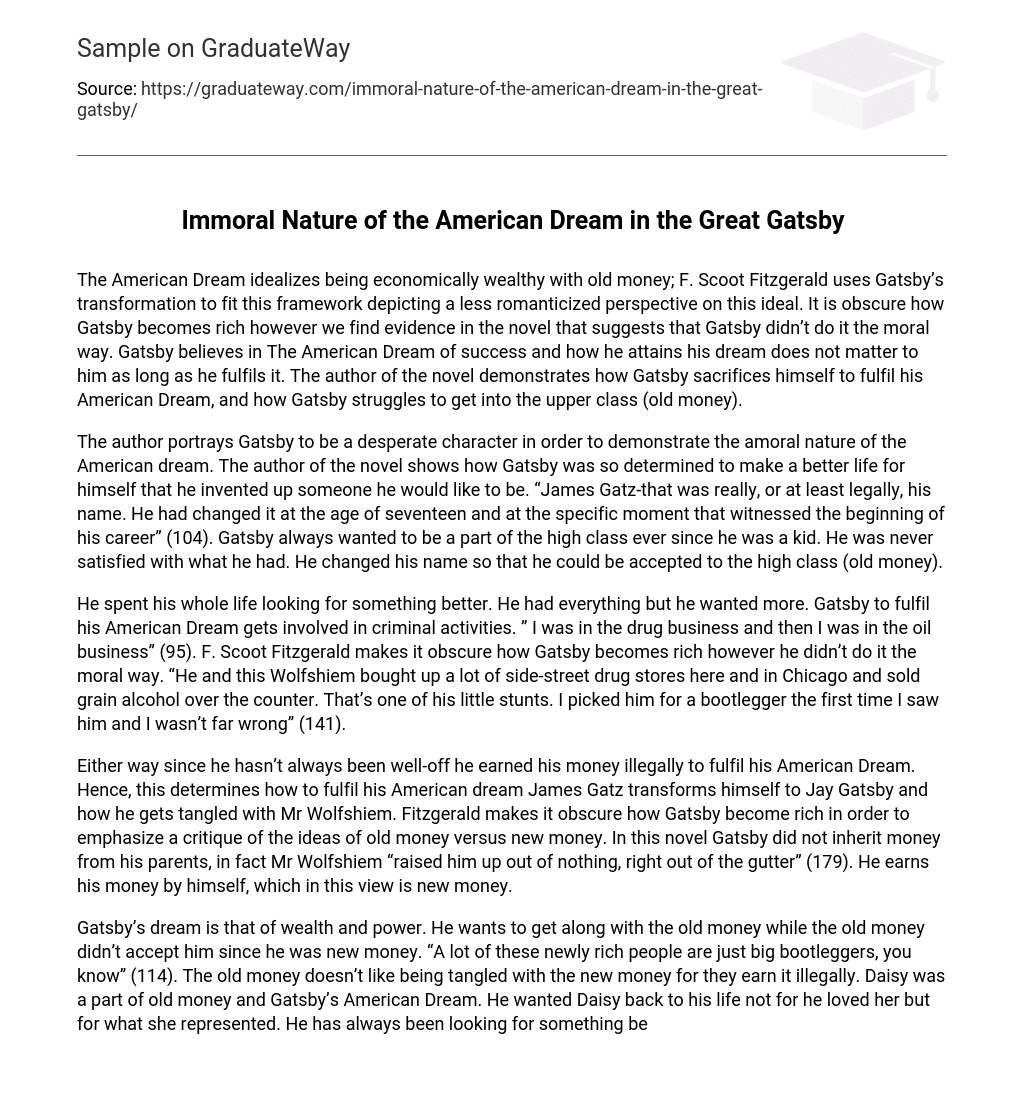F. Scott Fitzgerald portrays a less romanticized perspective on the ideal of the American Dream, which glorifies economic wealth and old money. Gatsby’s transformation aligns with this ideal, although it remains unclear how he becomes rich. The novel offers evidence suggesting that Gatsby did not acquire his wealth through moral means. Regardless, Gatsby remains steadfast in his belief in the American Dream of success, valuing fulfillment over the moral path to achieving it. Through the novel, the author demonstrates Gatsby’s self-sacrifice in pursuit of his American Dream, as well as his struggle to penetrate the upper class of society (old money).
The author illustrates Gatsby as a desperate individual to showcase the morally corrupt essence of the American dream. In the novel, the author demonstrates how Gatsby’s unwavering determination to improve his life led him to create an entirely new identity. According to the text, Gatsby’s real name was James Gatz, which he altered at seventeen years old as a symbolic commencement of his aspirations. From a young age, Gatsby yearned to be a part of the upper social class and was perpetually unsatisfied with his current circumstances. Consequently, he changed his name to gain acceptance into the esteemed high class (old money).
Despite having everything, Gatsby spent his entire life searching for something better, driven by an insatiable desire for more. In order to achieve his version of the American Dream, he became involved in criminal activities. According to F. Scott Fitzgerald, Gatsby’s acquisition of wealth remains uncertain, but it is evident that he did not obtain it through moral means. As one character recalls, “He and this Wolfshiem purchased numerous small drugstores in both this city and Chicago, where they sold illicit alcohol under the guise of legitimate business. That’s just one example of his deceptive tactics. I suspected he was involved in bootlegging from the beginning, and my intuition was not far from reality” (141).
Regardless of the path he took, James Gatz was not always wealthy. He resorted to illegal means to achieve his American Dream, which led to his transformation into Jay Gatsby and his association with Mr. Wolfshiem. Fitzgerald purposely leaves the origins of Gatsby’s wealth ambiguous to highlight a critique of the contrasting concepts of old money versus new money. Unlike inheriting his wealth, Gatsby’s money was earned through his own efforts. Therefore, it can be considered new money.
Gatsby hopes to achieve wealth and power, desiring acceptance from the old money despite their rejection of him as new money. The old money holds disdain for the new, believing their wealth is obtained through illegal means. Daisy, a member of the old money and Gatsby’s embodiment of the American Dream, is his desired possession not solely out of love but for the symbolism she represents. Gatsby engages in various unlawful activities in pursuit of money, success, and Daisy. He yearns for her presence so intensely that he trembles at the thought, extending his arms towards the darkness by the water. A distant green light serves as a poignant reminder of his desperation to have Daisy in his life. The author portrays Gatsby standing alone in the dark, reaching out towards the sea, while Daisy resides just across the bay. Despite this proximity, Gatsby feels compelled to purchase a house in that particular location, hoping to have Daisy within reach. Gatsby frequently throws lavish parties every week, longing for the day he will encounter Daisy once again.
According to the narrator, Gatsby’s parties were not attended by many invited guests. Instead, people would enter without knowing who Gatsby was. The narrator states, “I believe that on the first night I went to Gatsby’s house I was one of the few guests who had actually been invited. People were not invited-they went there” (45). This highlights Gatsby’s desperate desire for Daisy to fulfill his American dream as he hosted weekly parties and lived across from her. Additionally, Gatsby aimed to prove to Tom that Daisy always loved him and not Tom. He hoped that Daisy would tell Tom, “I never loved you” (116). This demonstrates how far Gatsby was willing to compromise his morals.
Daisy was married to Tom, but he refused to let her go and still desired her to fulfill his American Dream. He disregarded whether or not Daisy had a daughter, as all he cared about was the fulfillment of his dream. Meanwhile, Gatsby worked tirelessly to achieve his own American Dream, but ultimately failed as he was murdered by Wilson. Ironically, Wilson believed Gatsby to be responsible for his wife’s death, unaware that Daisy was the one who killed Myrtle. In the end, Gatsby was left with nothing despite his wealth and extravagant parties, as no one attended his funeral.
He engaged in criminal activities in order to attain the American Dream, molding his identity into the person he aspired to be. His intense desire for Daisy went unfulfilled, as he used her as a mere stepping stone towards his ultimate goal. Although he didn’t truly love Daisy, she was a crucial piece in Gatsby’s pursuit of the American Dream. Unfortunately, his efforts yielded nothing but his own demise. This exemplifies the extent of Gatsby’s desperation to realize his American Dream. Additionally, the author aims to expose the ethically questionable nature of this ideal.





